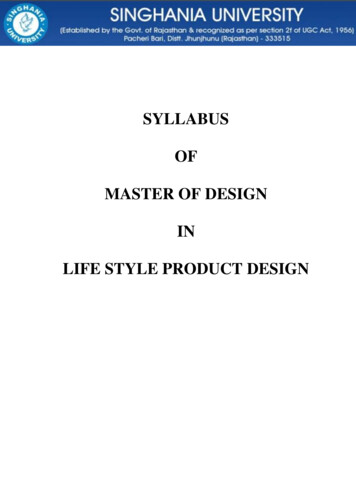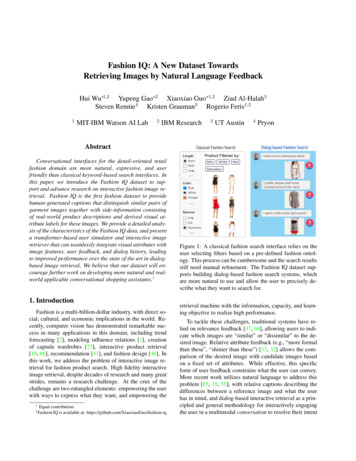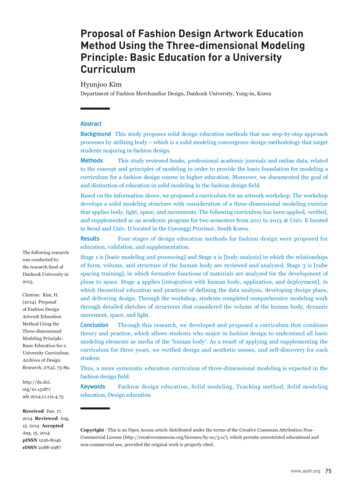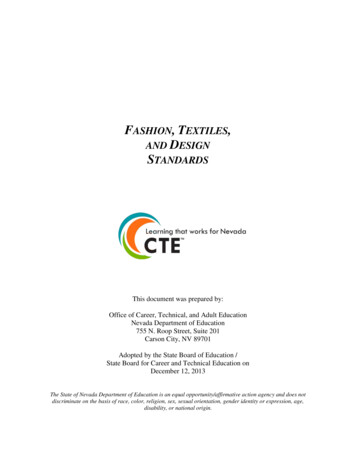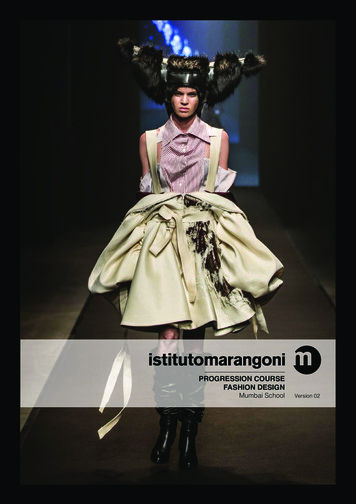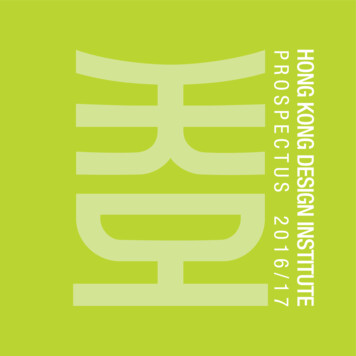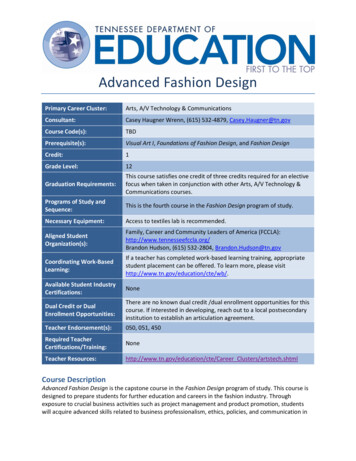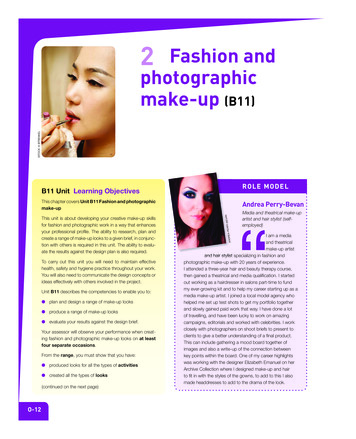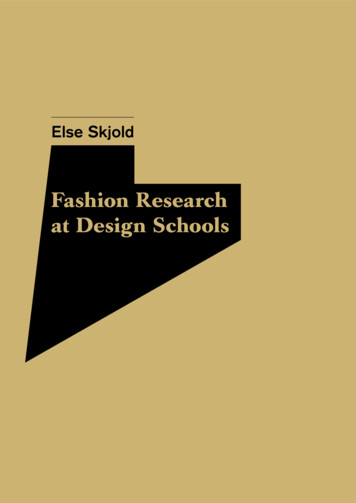
Transcription
Else SkjoldFashion Researchat Design Schools
Fashion Researchat Design Schools
Else Skjold, Ph.D. scholar, Designskolen Kolding, 19th of February 2008The report has been commissioned by and conducted together withUlla R æbild, study co-ordinator for Fashion, Institute for Fashion and Textiles,Designskolen Kolding.The research project is financed by the Center for Design Research (CDF)within the framework of MOKO.Graphic Design: Rasmus Koch StudioProofreader: Kristin WhinfreyPrint: Backhausen aps
This report not only addresses researchers, but everyone who works inthe field of fashion, who wishes to know more about what fashion researchis, how it is currently being implemented at design schools in Europe and theU.S.A. and not least how it can potentially support and inspire the fashionindustry. In a few words, the project is fashion research on fashion research.It is the hope that this study can contribute to creating more qualified discussions as to how research could be conducted at fashion design educationalprogrammes in the future.Else Skjold19th of February 2008
Very special thanks to participants in my case studies:Professor Helen Thomas and assistant Lucy Corbally from “Centrefor Fashion, the Body and Material Cultures”, London College of Fashion( University of Arts, London), Professor José Teunissen and head of the B.A. infashion, Matthijs Boelee, ArtEZ Institute of the Arts, Arnhem (Holland),Senior tutor in menswear Ike Rust, head of Institute of Fashion and TextilesWendy Dagworthy, tutor at Departments of History of Design and Historicaland Critical Studies, Royal College of Art (London), Professor Emerita Lorraine Howes, head of Apparel Design Donna Gustavsen and Dean of Design and Architecture Dawn Barrett, Rhode Island School of Design(U.S.A.), Director Valerie Steele and Dean at School of Graduate StudiesSteven Zucker at FIT (U.S.A.), head of Fashion Design Department StevenFaerm, Assistant Professor Heike Jenss, Chair and Professor for Departmentof Art and Design Studies Hazel Clark, Parsons the New School for Design,Professors Eugenia Paulicelli and Joseph Glick, CUNY Graduate Center, NYCUniversity (U.S.A.).For support and guidance: My supervisor, Associate Professor Lise Skov( reative Encounters, CBS), my colleagues in MOKO and at DesignskolenKolding, A ssociate Professor Birgitte Munch, Department for Economy, Organisation and Management, Nord-Trøndelag University College, Norwayand Gitte Grønkær Andersen, cand. mag. in pedagogical sociology,consultant at EVA (DK).
Table of ContentsPart I: Conclusions11Aims of the Report11Designskolen Kolding13Conclusions of the Report15Recommendations for a research strategy in fashion at DKNetworks and partnerships in DenmarkInternational networks and partnershipsPart II: Presentation23Introduction23Key Questions25Structure and Methodology26Part III: Fashion Research in Context31Fashion as a Creative Industry31Interactions between ‘Creative Regimes’33Practice versus Research36Design Research in Denmark37Design Research at Designskolen Kolding39Conclusion41
Part IV: Case Studies (#1)45Presentation45Preliminary Study45Finding Relevant Cases50Presentation of Selected Cases55Elaborations on the Research Strategies58Implementation of Theory and Research in Curriculum65Centrum för Modevetenskap, Stockholm UniversityKyoto Costume InstituteConclusionJapanThe U.S.A.Italy, France, EnglandFinal cases: England and HollandConclusionArtEZ fashion in Arnhem and the Dutch programmeFBMCRCAThe Dutch programmeFBMCRCAConclusionArtEZ and the fusion of fashion industry, research and design-artistic basedfashion educationFBMC and the recruitment of new researchersRCA and the balance between curriculum and industryPart V: Case Studies (#2)73Presentation73Parsons The New School for Design74FIT78Curriculum and a future M.F.A., the Fashion Design DepartmentDepartment of Art and Design StudiesConclusionRISDValerie Steele and Yuniya Kawamura on fashion theoryConclusionApproach to research at RISDFashion design education at RISDConclusionCUNY8285Concluding Summaries89Literature90
10
Part I: ConclusionsAims Of The ReportThe aim of this report is to define positive ways in which fashion research can be integrated in the fashion design education at DK (Designskolen Kolding). The academisation of design education has come about asan irreversible top-down political process. This happened when the Danish Ministry of Culture formulated the goal that by 2010 the design schoolsshould be accredited with status as universities.1However, the demand for academisation is supported by a numberof other factors, which include the overall structural changes in the fashionindustry that now requires fashion designers to be knowledge workersrather than only hands-on clothing production experts. In this situation, both students and employers demand that the focus of fashion design educationbe revised. Secondly, an academic standardisation will allow for increasingexchange and collaboration with other academic institutions. In Denmark, thisprimarily means a closer collaboration with the other universities, for examplethrough student exchanges, combined degrees and research projects. In theinternational arena, there is a possibility for creating partnerships with academic design schools in the U.S., the U.K. and elsewhere in Europe, such asHolland and Sweden.It is clear that students at a design school are not university studentsand that the primary purpose of fashion design education should not be toteach students how to do research, as it was in the old elite universities. Itis vital that the implementation of theory and research procedures supportstudents in being good practicing designers. Therefore, the crafts-basedknowledge accumulated in a design education should not be neglected or lostin this academic transition and replaced by academic traditions that are notadapted to the specific needs of a design school. Otherwise, the result wouldbe a fragmented education in which students would neither learn to workas designers nor do research and in which the different requirements of the curriculum would appear meaningless.1According to the contract between DK and the Ministry of Culture 2007-10.11
Presently, fashion research is an interdisciplinary field that has developed in academic disciplines such as art history, cultural studies, history,sociology, anthropology, consumer studies, ethnology, etc. Fashion is relatively under theorised compared to other aesthetic fields, such as architecture, industrial design or art. The fact that fashion research can be said to bean academic ‘rag rug’ is a major opportunity for the design schools. They canhave a unique influence on the emerging consensus about fashion research,which is being established within a growing network of fashion researchers. More specifically, the design schools can ensure that practice is broughtto bear on fashion research, both as a general perspective that is reflectedin all research projects and also specifically through so-called practicebased research, which is conducted by practitioners who study problems or challenges c oncerning the production and creation of fashion.12
Designskolen KoldingDesignskolen Kolding is a relatively small school situated in Jutland, nearthe traditional centre for the Danish fashion and textile industry. Approximately360 students are studying the areas offered by the school at the B.A. level(3 years of study) and M.A. level (2 years of study). These areas are the Institute for Fashion and Textiles, the Institute for Industrial Design and InteractiveMedia and the Institute for Visual Communication. Besides these there arethe Institute for Form and Theory, which is an interdisciplinary platform thatcombines academic theory and practice of all institutes into various modulesin the curriculum, and the Research Department employing 3 senior researchers, one post-doc, nine Ph.D.s and two research assistants. Out of this, onePh.D. is working on fashion, while two senior researchers, two Ph.D.s andtwo research assistants are working on textiles. At the Institute of Fashionand Textiles, approximately 30 students are accepted each year from between130-150 applicants, based on a screening which takes into account exam papers and a two week assignment .2 For selected applicants, a further test andan interview are conducted to find the final 30 students. The fact that fashionand textiles are situated in the same institute at DK is a deliberate choice thathas created synergies and collaborative projects combining the special skillsfrom each area. Since the institution is under the Ministry of Culture, the education is free of charge and students receive state education grants while theyattend.Due to the location in a provincial town, it has always been difficult toattract full time teachers. Many classes are short workshop courses led by visiting professionals from Denmark and abroad. At times, this has caused discontinuities. However on the overall, it is believed that this has strengthenedthe orientation towards practice, because designers working in the fashionindustry have been dedicated to teaching in short modules. When it comes toresearch, DK has chosen a not particularly straightforward strategy of combining practice-based and theory-based research, an approach that permeatesthroughout the entire institution.3A small, but still growing, research environment has caused a fewbumps in the road. This is due to the lack of experienced researchers, who areessential to creating fruitful and constructive discussions and supervising research assistants and Ph.D. students, especially practitioners who for the firsttime have had to create a theory-based framework for their practice-based2A dispensation for exam papers can be made for especially talented appliers.3A more detailed definition will follow later in this chapter.13
research projects.4 On the other hand, the reward for this at times painfulprocess is has recently begun to culminate in a growing number of staff whocombine theory and practice in a very natural and constructive way and whoare able to verbalise stages of the design process on a higher level than fromwhen before they started researching. However, it is crucial that strong networks be established between academic institutions that can support andstrengthen the academisation process and that the special needs and challenges relating to research at design schools be directed and analysed in order to help establish a stronger research environment. Otherwise, manyof the design school researchers will not be taken seriously within a purelyacademic framework.The following conclusion is based on the content of this report, and allissues mentioned will be elaborated on and supported by empirical studies,literature and concluding arguments in later chapters.414Two practice-based Ph.D.s were never finalised, one in 2006 and one in 2007. This was, among other things, due to thelack of relevant supervising and a strong research environment that could have supported the two scholars.
Conclusions Of The ReportPractice-based research and the implementation of academic researchat design schools are relatively new phenomena in Denmark. However, thedecision made by the Ministry of Culture in the 1980s to change the name ofthe design education from ‘arts and crafts schools’ to ‘design schools’ is partof a long course of development where the notion of what design is and whatskills it takes to create it have changed a lot, which makes the implementationof research in the education a natural step forward. The debate concerningresearch as such versus practice-based training has caused a very heated public debate over the past few years. This is because it is not only a discussion about how to teach, but also a matter of whose knowledge is most valuable in relation to the students and the industry. Is it academic or practicebased knowledge?Practice-based and theory-based research on fashion can be definedas follows:Practice-based research is research on design processes, designersand industry where research questions are formulated from within theprofession, thus creating knowledge that is valuable for the practice-based training of students and as expertise for the fashion industry. In this workthere is a great need for verbalising the ‘tacit knowledge’ concerning thedesign process for fashion designers, and it seems that design research ingeneral and fashion research in specific are being undertheorised as it is ina descriptive phase that is very necessary and valuable in order to developand create i nnovation in education and industry.Theory-based research is research concerning fashion as a culturaland economic phenomenon. It is a field that has grown explosively over thelast 15-20 years. Researchers educated within a wide variety of very established academic disciplines are increasingly looking into fashion or the design processes in fashion. From the viewpoint of a design school, the obvious is tocarefully select what approaches are most easily combined with the alreadyexisting core competencies and what bodies of knowledge could best supportthe chosen strategies.Through a study of relevant literature that touches upon fashion as acreative industry, the tensions and potentials of design research in relationto the so-called “expanded notion of design” and various qualitative case studies from a selected range of international design schools, this conclusionstates how DK could find its own way of creating a well-balanced strategy for fashion research where academic content is used as a resource in the fashiondesign education. The aim is for academic content to be introduced all the15
way from the B.A. and M.A. level to the senior researcher level and to thepractice-based tutors, which would create a fruitful synergy between theoryand practice. Therefore making theory just another tool available for studentsnext to draping, drawing, cutting, etc.The key questions here are:“What kind of fashion design education is DK aiming to offer in thef uture, what kind of skills will the students need in their future workplace,the fashion industry, and can research work as a potential in this process?”Recommendations for a research strategy in fashion at DKBased on the analyses, comparisons and discussions presented in thisreport, it is recommended that the strategy of fashion research be a ratheropen and fluid multi-strategy with its basis in a well-adjusted balance betweenpractice-based and theory-based research. The Royal College of Art (RCA) isa primary template for where to begin. Just like at the RCA, it seems pivotal tohave staff members at DK who are supported by theory and who strengthenthe crafts-based traditions. The school obviously wants to produce “materialknowledge” as well as hands-on expertise, not only “immaterial knowledge.”5The recommendation of pursuing a multi-strategy is based on the verypragmatic notion that DK is a small provincial school, which because of thishas to be aware of how to expand the number of its own researchers and support research projects and researchers that incorporate more than one areaof design or theory. Firstly, as strong a research environment as possible mustbe established with the means available. Even if the design schools have todo research, they do not get the necessary funding. As a result, some of themeans have to be found elsewhere in the institution, often coming from thepractice-based courses or other teaching facilities. This is why it is so important to have theory tightly integrated into the practice-based teaching.It is also important to create a strategy that does not exclude potential research candidates who want to work and even live in the Kolding area.There is an ongoing debate about how to best support design students whohave an interest in research. In terms of recruitment, there are some individual courses at Danish universities that are related to or address fashion516The need for this is described in an article in the Guardian, January 29th 2008, “Cheap and twice the price.” Here, itis stated that even many so-called luxury brands cannot find sufficient craftsmanship. Everybody wants to be designsuperstars; no one wants to be an anonymous technician.
through issues like gender, sociology, anthropology, visual culture or mediaculture etc. But there are currently no real traditions or established frameworks for studying fashion at universities in Denmark, although interest among university students seems to be growing. So it is now more or less a questionof capturing candidates who want to go further with fashion research, independently of what academic training or research interests they may haveor what “trends” are dominating the field of fashion research.Even if the research strategy should be fluid and open towards newfields of research, there are areas that seem more obvious for DK than others,because of the accumulated competencies already existing at the institutionand the perceptions among staff members of how to approach fashion design.Strongly inspired by the ‘Centre for Fashion, the Body and Material ulture’ (CFBM) at London College of Fashion, it is suggested that theseCthree aspects should, in a fluid triangular combination, be the main focus forfashion research at DK:Research on fashion should be directed towards fashion as a culturalor economic phenomenon, which could be studies on the fashion system,consumer studies or studies in aesthetic meaning or expression in fashion.Research on the body can consist of theories about embodiment orfashion or dress as a bodily practice or it can be practice-based projects oncutting, shaping, body mapping, etc.Research on material culture should consist of practice-based projectswith an industry focus that have potential for collaborations between textileand fashion researchers and external partners, the hands-on development ofor innovation of fabrics and knitting or, once again, theory-based projects onfashion or dress as a bodily practice.These three aspects could, as said before, be combined with variousweights in one project, which would be advisable in the current building upof the research department. However, they could easily be treated separatelyin later projects. This recommendation again stems from purely pragmatic reasons, namely that in a small research environment every single researcherhas a responsibility to cover more fields of knowledge. While in a larger environment or institution, there is more room for niche projects. The three aspects also open up for a discussion of how textile and fashion researchcould best be combined to form theoretical frameworks that would supportthe many collaborative projects already taking place at the student level. Thisway the already existing perception that DK wants to maintain a strong focuson practice can be enhanced, developed and augmented through research.17
While the three aspects (the body, fashion and material culture) shouldform the basis of the research strategy on fashion, there are nonetheless moreissues which seem obvious to study that could form natural continuations ofthe main elements:There is currently a very strong focus on ethics, sustainability andenvironment in the fashion industry, popularly known as CSR (Corporate Social Responsibility). This is a very natural issue to pursue in both curriculumand research. Such projects could have widespread methodological focalpoints and aims. These projects could easily create opportunities to establish collaborative practice-based projects with the fashion industry and thus contribute to innovation in the Danish production of fashion.Another issue that relates to the descriptive phase in general designresearch is the development of a didactic strategy. The jobs done by fashiondesigners have changed dramatically with the globalisation of clothing production. Even so, job functions are understudied and in need of critical reflection through research. This is especially true in a small research environmentlike DK, where the focus is placed strongly on developing research-basedteaching both in practice and in theory. It could prove valuable to study anddevelop how to strengthen the verbalisation of the fashion design process,how sketching processes or visual research can be improved or how studentscan get the most out of theory in combination with their main focus – design.This kind of research would lead to an improved understanding of the fashiondesign profession, its place in the national and international business systemand the creative and cognitive processes of fashion design.Networks and partnerships in DenmarkThere is a widespread agreement that DK cannot go through its academic upgrading alone. It is essential to establish networks and morebinding partnerships with selected educational institutions or fashion companies in Denmark and abroad, in order to be able to have co-funded researchprojects and to share knowledge. To select the right partners it is necessaryto constantly be aware of and to define what core competencies and goalsDK pursues in the fashion design education and how and with whom it is possible to move forward.In this process, it is extremely important to have a positive and constructive dialogue between the research department and the Institute ofFashion and Textiles. Fortunately, this is already happening to a large extent,because of the small size of DK everyone meets at lunch or in the hallways. Nevertheless, this dialogue could be more focused, for instance by bringing18
researchers and practitioners together in teaching workshops. DK has alreadystarted experimenting with such projects with great success, just like theInstitute for Form and Theory is experimenting with teaching processes thatcombine practice and theory.To have a constructive dialogue externally, obvious partners in Denmarkto obtain qualified knowledge from during this process could be the following:Other institutions that are involved in constituting traditions andmetho dologies in design research: This has already been establishedto a large degree through the “Center for Design Research” (Center for Designforskning, CDF), which is a platform for design research involving thetwo architecture schools and design schools under the Ministry of Culturein Denmark. The Danish platform for fashion research, Modekonsortiet (TheFashion Consortium, MOKO), located at Denmark’s Design School (DKDS) inCopenhagen, is also a very useful partnership that can be developed further.Furthermore, a dialogue between the Textile Consortium, located at DK, andMOKO could help develop interdisciplinary methodologies between fashionand textiles.Business schools with a focus on creative industries:Here, DK has already established a partnership through MOKO with theCopenhagen Business School (CBS), which has been active in establishingresearch in creative industries, both through the centre “Imagine.CreativeIndustries Research and the research programme reative Encounters. As ofJanuary 2008, a Ph.D. in fashion has been co-financed by the Department ofIntercultural Communication and Management at CBS and DK.University departments with a strong focus on culture, art history orsociety:Such a partnership has not yet been formed, but there could be potential indeveloping a partnership with University of Southern Denmark that has institutes relating to these areas located in Kolding.Institutes or institutions of pedagogy:Such a partnership has also not yet been established, but a potential partnercould be the centre “Learning Lab” at the School of Education, University ofAarhus (DPU).The fashion industry:Here the practice-based research to be developed at DK could prove potentially very valuable for the industry, and since Kolding, as mentioned before,is located in the traditional fashion and textile region of Denmark, it ought tobe possible. Also, the Danish trade organisation for fashion, “Federation of19
Danish Textile and Clothing” (DTB), is located in this area. An informal partnership between MOKO and the “Danish Fashion Institute” (DAFI), a networkorganisation that promotes Danish fashion, has also been established. Thoughthere have already been established two co-financed Ph.D. projects on textiles between DK and the textile industry, the fashion industry still seems quitecautious and reluctant towards fashion research. There is a huge challenge inthe following years to either start a conversation with the industry through thementioned organisations or to start on pioneer projects, in order to convincethem that an involvement with research can be worth their time and money.International networks and partnershipsIn the building up of a balance between practice-based and theorybased research on fashion at DK, the RCA in London and RISD in U.S.A.seem extremely relevant as exchange and discussion partners, especially asthese institutions have also established a close connection between fashionand textiles. The interest for RISD is also stated in the report “Research inTextile Design” (Bang & Nissen, 2005). This is a preliminary study for theestablishment of the Textile Consortium. Just like attempts to build a networkwith textile researchers at the RCA, this is an ongoing process.In terms of the building up of a theoretical framework on the economicaspects of the fashion industry and how to implement theory and managementrelated issues in the practice-based education, the M.A. “Fashion, Design& Strategy” (F, D & S) at ArtEZ in Arnhem and the Dutch trans-institutionalprogramme on fashion research, which has as of now partly been establishedin Holland, are also of great interest to DK. Just like in Holland, the Danishfashion industry consists of partly economic driven and partly design drivenfashion companies. Since the economic aspect of fashion is not a core issueof research at DK, this is a field where a partner is needed. In the partnershipbetween DK and CBS/Creative Encounters, it seems highly relevant to furtherdevelop exchanges in courses and research projects with inspiration from theDutch cases studied in this report.Since fashion research is developing so rapidly these years, it is vitalto keep a strong network within the already established strong internationalcentres for fashion research and the ones that are in the making. At CUNYGraduate Center, Parsons the New School for Design6 and the FIT in NewYork City, the FBMC in London and Stockholm University, it seems from620It can be mentioned that Parsons the New School for Design and DK as of December 2007 have established a collaboration/dialogue regarding CSR.
the evidence in this report that everybody seems interested in exchanging knowledge, even tutors and courses via seminars or via online teaching. Thisis a huge area of high interest for DK and MOKO, and it should be furtherdeveloped in the near future. To tie all these knots together and to make theminstrumental for DK, it is vital that the school be able to attract researchersand tutors from abroad. With the great number of tutors visiting already, itwould seem obvious to apply for funding for a college or prestige building thatcould provide housing for visiting staff members. This could not only save theschool the extensive part of their budget that now goes to pay for hotels forthe visiting tutors, but it could also create an attractive housing possibility inthe beautiful area of Kolding where fruitful meetings and discussions couldcontinue after work and help establish even stronger liaisons and partnerships.21
22
Part II: PresentationIntroductionThis report has been requested by and conducted in collaboration withUlla Ræbild, study co-ordinator for Fashion, Institute for Fashion and Textiles,Designskolen Kolding (DK), as the first step towards establishing fashionas a research field at DK. The starting point of this report was to establisha preliminary study and to find inspiration for how fashion research couldbest be established at DK, in order to make the school an active partner inMOKO, which was established 2 February 2006. Until then fashion researchin Denmark was conducted sporadically at universities, museums or by singleresearchers, musicologists or students, but the knowledge they developedwas not necessarily disseminated. As follows, one of the goals of this reportis to contribute to the consolidation of MOKO by enhancing the collaborationbetween its institutions, specifically the two Danish design schools DK andDKDS.This report is conducted from the viewpoint that it is of vital importancethat fashion researchers and design schools share knowledge at this point intime and that this can be done by a disclosure of the role played by fashionresearch at fashion design educations, their students and the relations tothe fashion industry in qualitatively selected cases from outside Denmark.The growing interest for fashion research, not only in Denmark but in a greatnumber of other countries, seems to stem first and foremost from the factthat many countries have undergone a transformation from being fashionclothing producers to being fashion design producers. In a time where arelatively small amount of clothes are produced in the Western countries likeEurope and U.S.A., an issue is to enhance the ability to produce ideas, whichof course stimulates the interest for looking at fashion in new ways. Thesechanges inevitably afflict the design educations. It is most apparent that design schools in the mentioned regions find themselves in a transitional phasewhere the question of how to best supply the fashion design students withappropriate skills for the reality that meets them when they finish school isheavily debated.To qualify this debate in Denmark, it is obvious to study how thesechallenges are met abroa
the field of fashion, who wishes to know more about what fashion research is, how it is currently being implemented at design schools in Europe and the U.S.A. and not least how it can potentially support and inspire the fashion industry. In a few words, the project is fashion research on fashion research.
